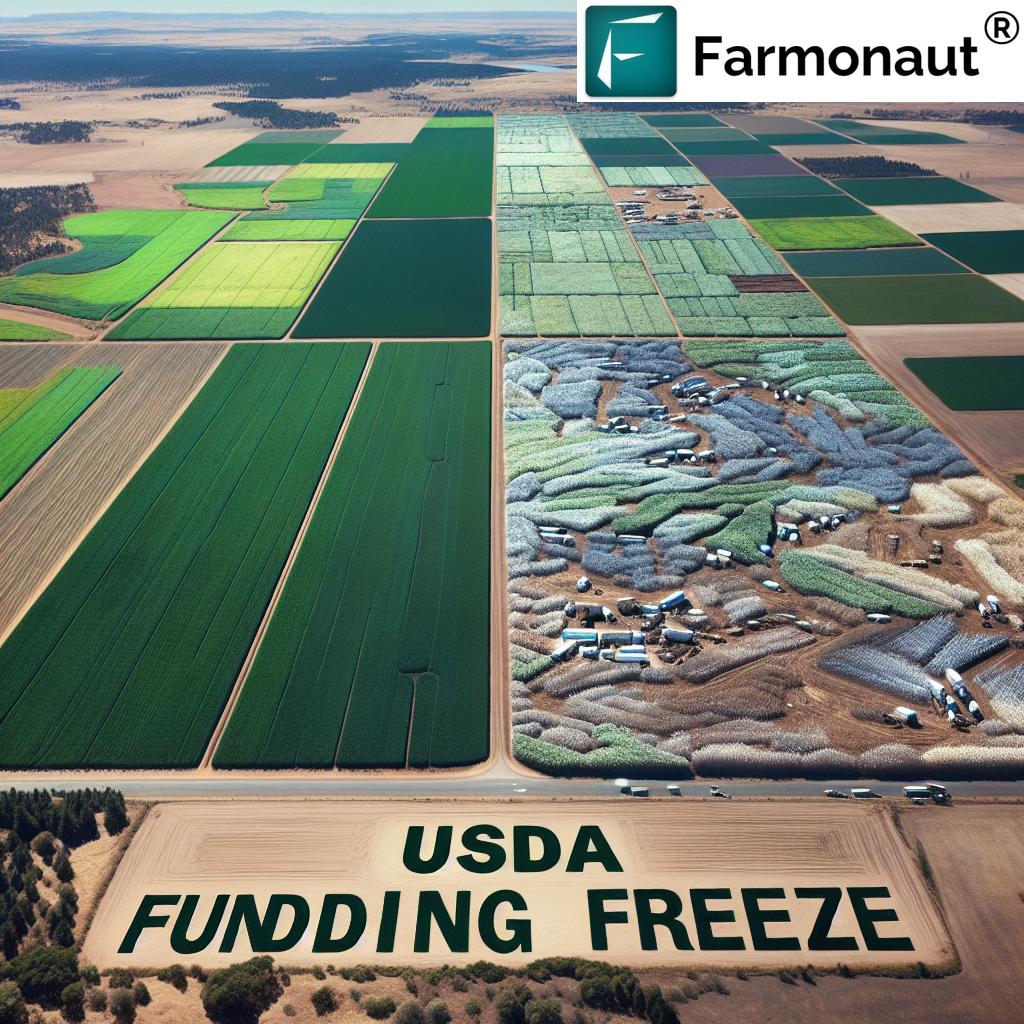Maine Farmers USDA Funding Issues: 7 Key Impacts
“Over 60% of Maine farmers rely on USDA funding; recent cuts threaten local food sourcing and sustainability programs.”
Introduction: Understanding USDA Funding for Maine Farmers
Maine’s agricultural sector has always been a defining pillar for the state’s economy, rural culture, and sense of community. For years, USDA funding and support programs have been essential in keeping local farms competitive, fostering sustainable agricultural practices, and building robust food systems that connect local schools, food banks, and consumers with Maine farmers.
In this comprehensive blog post, we examine the impact of recent USDA funding cuts—implemented in early 2025—on Maine’s farmers, communities, schools, and agricultural programs. We highlight the seven key impact areas resulting from these federal actions. Our goal is to inform and empower Maine’s agricultural stakeholders, policy advocates, and the general public about what’s at stake, while suggesting pathways for resilience and progress.
USDA Funding Cuts 2025: What Changed and Why It Matters
In early 2025, the U.S. Department of Agriculture (USDA) implemented significant funding cuts and restructured multiple federal support programs for farmers. Among the most consequential actions were:
- The discontinuation of the Local Food for Schools Cooperative Agreement (LFS) and Local Food Purchase Assistance Cooperative Agreement (LFPA).
- The cancellation of the Partnerships for Climate-Smart Commodities program, which planned to inject $3 million into climate-resilient farming projects across Maine.
- Suspension of over $12 million in conservation contracts in Maine—approved by the USDA’s Natural Resources Conservation Service (NRCS)—leaving projects and assistance in limbo.
- A legal dispute that led to the withholding of over $5.7 million designated for Maine’s child nutrition and adult care programs.
These USDA funding cuts have sent shockwaves through Maine’s agricultural sector. The impacts go beyond farm budgets—they threaten food security in rural communities, undermine sustainable farming practices, and reduce opportunities for research and innovation that have long defined agricultural programs in Maine.
For hundreds of farmers in Maine, schools, food banks, and related industries, the uncertainty is palpable. With the federal safety net weakened or removed altogether, families and organizations are bracing for difficult decisions that could have lasting repercussions across the state.
Impact Overview Table: Seven Key Areas Affected
| Impact Area | Estimated Funding Reduction | Affected Stakeholders | Potential Consequences |
|---|---|---|---|
| Local Food Sourcing Initiatives | $2M+ (in school and food bank purchases) | Small & mid-sized farmers, local schools, food banks | Reduced purchase of local produce; lower farmer incomes; reliance on processed foods |
| Sustainable Agricultural Programs | $3M (climate-smart grants lost) | Farmers, agricultural NGOs, environmental partners | Stalled climate resiliency projects; slower adoption of sustainable practices |
| School & Nutrition Programs | $5.7M (child & adult nutrition) | Schools, meal sites, vulnerable families, disabled adults | Decreased food security; higher rates of hunger in communities |
| Conservation Assistance Programs | $12M (contracts put on hold) | Farmers, conservationists, state agencies | Paused environmental projects; loss of technical support |
| Agricultural Research & Education | Est. $1M+ (UMaine/research programs) | Researchers, university students, farmers | Research delays; limited access to new farming solutions |
| Economic Stability of Rural Communities | Widespread (affecting >1,200 farms) | Farmers, local businesses, rural residents | Potential job losses; reduced economic activity; rural decline |
| Advocacy, Legal Actions, & Alternate Paths | Funding in jeopardy (awaiting resolution) | State agencies, advocacy groups, local farmers | Uncertain program futures; need for policy change and innovation |
“Federal funding reductions could impact up to 1,200 Maine farms, affecting community food access and agricultural jobs.”
1. Local Food Sourcing Initiatives: Disrupted Access and Revenue
Local food sourcing initiatives, like the USDA’s Local Food for Schools Cooperative Agreement (LFS), were created to empower local schools and food banks to buy fresh produce and meats directly from Maine farmers. These programs not only supported the economic growth of farms across the state, but also ensured that children, families, and vulnerable populations received nutritious, locally sourced food.
The recent USDA funding cuts have abruptly ended these agreements, forcing over 60 school districts and dozens of food banks to reduce or even eliminate their purchases from local farms. For many small and medium-sized agricultural producers in Maine, these contracts provided vital and predictable income, helping them weather seasonal fluctuations and market uncertainty.
Impacts on Maine’s Food System:
- Reduced revenue for local farms, threatening their stability.
- School cafeterias must switch to less expensive, often highly processed foods, undermining healthy eating initiatives.
- Food banks are less able to distribute fresh produce to communities.
- Heightened food insecurity in rural communities that already face limited access to nutritious options.
For Maine farmers and school administrators alike, the need for resilient local food sourcing initiatives has never been more apparent. These programs ripple beyond agriculture—they underpin the physical and economic well-being of entire towns.
2. Sustainable Agricultural Programs and Practices: Setbacks for Maine
Sustainable agricultural programs have, in recent years, enjoyed broad support and recognition as critical to Maine’s economic and environmental future. Initiatives funded by the USDA had prioritized resilience to climate change, promotion of regenerative practices, and diversification of agricultural production.
One of the most severe blows from the 2025 USDA funding reductions was the cancellation of the Partnerships for Climate-Smart Commodities program, which earmarked $3 million for Maine-specific projects. These projects were to help local farmers develop climate-resilient practices, expand cover cropping, test new soil health protocols, and invest in carbon reduction efforts.
Instead, the department announced plans for a new funding model (“Advancing Markets for Producers”), requiring 65% of grant money to go directly to farmers. This shift, while positive in intent, has left a gap in continuity and stalled the launch of new conservation and climate projects.
The Threat to Sustainable Farming in Maine:
- Paused or canceled climate-adaptive pilot projects and community demonstration farms.
- Increased uncertainty and risk for farms facing erratic weather and shifting growing conditions.
- Carbon footprint reduction and climate reporting, previously incentivized by USDA funds, now see lower adoption rates. Maine farmers must seek new tools and partners to measure and improve their carbon impact.
- Maine’s progress in sustainable agriculture is at risk—potentially reversing years of environmental gains.
By prioritizing short-term cost savings over long-term sustainability and resilience, these funding cuts jeopardize the environmental integrity of Maine’s farming sector and reduce its ability to withstand future shocks.
3. School and Nutrition Programs: Diminished Food Security
Beyond their effect on farms, the USDA funding cuts have triggered a direct crisis for school meal programs, after-school nutrition initiatives, and care centers for disabled adults throughout Maine. With over $5.7 million withheld from nutrition assistance funds via legal dispute, many local agencies now must scale back the frequency and scope of their meal services.
Consequences for Maine Schools and Communities:
- Fewer locally sourced, fresh foods served in school meals.
- Disruption to routine nutrition in childcare and disabled adult care centers.
- Increased reliance on processed, pre-packaged foods, contributing to poor nutritional outcomes.
- Food insecurity rates likely to rise across rural and low-income communities.
The domino effect from USDA funding issues doesn’t just reduce sales for farms—it slows children’s development, raises health concerns, and heightens pressure on teachers, administrators, and staff tasked with caring for Maine’s most vulnerable students and adults.
Advocacy groups and state lawmakers continue to press for the reinstatement of these crucial funds, emphasizing their role in ensuring strong community nutrition and food security.
4. Conservation Programs for Maine Farmers: Delayed and at Risk
Conservation efforts are foundational to modern agriculture in Maine. Thanks to the USDA’s Natural Resources Conservation Service (NRCS), Maine farmers have historically accessed technical assistance, grants, and contracts to promote soil health, restore wetlands, improve water quality, and adopt responsible land stewardship.
In 2025, however, over $12 million in Maine conservation contracts were abruptly put on hold. According to the Maine Organic Farmers and Gardeners Association (MOFGA), the fate of these programs—spanning cover cropping support, habitat restoration, and erosion control—remains uncertain.
Immediate and Long-Term Effects:
- Paused hiring of seasonal conservation specialists, impacting local employment.
- Delays or cancellations of projects designed to protect sensitive habitats and shorelines.
- Weakening of Maine’s defense against climate disruptions, pests, and diseases.
- Farmers losing access to guidance and resources for best conservation practices.
For many, this erosion of federal support for farmers signals a step backward in the ongoing effort to balance production with environmental stewardship. Timely assistance is key to sustaining Maine’s landscape and way of life.
5. Agricultural Research and Education: University of Maine in Limbo
New ideas and best farming practices often begin in the lab and get tested in the field. In Maine, the University of Maine System has hosted influential research on PFAS (“forever chemical”) contamination, biofuel feedstocks, and eco-friendly pest management.
When the USDA freeze placed these projects on hold, the ripple effects were immediate:
- Delayed Maine agricultural research on critical issues affecting public health and environmental sustainability.
- Halt of pilot studies that guide farmers, forestry professionals, and cooperatives in adapting to change.
- Reduced educational opportunities for university students to engage in hands-on agricultural problem-solving.
- Interruptions in knowledge transfer to extension services, agricultural trainers, and farmer networks.
Without predictable, stable research funding, Maine’s ability to stay ahead of agricultural threats—and to seize new market opportunities—diminishes.
6. Economic Stability and Rural Communities: Uncertain Futures
Farm economies are more than numbers—they are the mainstay for Maine’s rural identity. Each dollar spent in a local farm operation circulates throughout the region, supporting suppliers, equipment dealers, schools, and family-owned businesses.
The threat to more than 1,200 farms from USDA funding cuts puts entire communities at risk:
- Farm closures or downsizing due to loss of consistent income and investment in innovation.
- Job losses in agriculture, food service, and supply chain businesses.
- A downward spiral in economic stability for rural communities, leading to population loss and increased poverty rates.
- Fewer opportunities for young people to enter or remain in farming.
Broader Social Impacts:
- Rural decline—as families depart for more secure livelihoods, local culture and traditions suffer.
- Community well-being is stretched as essential services (schools, clinics, recreation) face shrinking budgets and demand.
The long-term consequence? Without swift action, the very communities that built Maine’s agricultural legacy may be left behind.
7. Advocacy, Legal Actions, and Alternate Paths Forward
Recognizing the gravity of the situation, Maine officials initiated a lawsuit against the Trump administration to challenge the withholding of crucial nutrition funds. This fight, rooted in the interpretation of Title IX, represents a larger advocacy movement for the future of USDA program support in Maine.
Ongoing Advocacy Efforts:
- Appeals from U.S. senators, state lawmakers, and farm advocates urging the USDA to reinstate local food sourcing programs and essential nutrition assistance.
- Grassroots efforts led by groups like MOFGA, providing resources and support to farmers facing funding uncertainty.
- Innovative funding and insurance solutions emerging as farmers look for non-federal ways to buffer risk and maintain liquidity.
These efforts underscore the need for:
- Legislative and regulatory clarity that protects federal support for Maine’s agriculture sector.
- Flexible, technology-driven tools to supplement traditional USDA programs.
Advocacy remains critical as the impacts of funding cuts on agriculture are felt in every corner of the state—from the most remote blueberry farms to bustling farmers’ markets in Portland.
Farmonaut: Technology and Tools Empowering Farmers
As Maine farmers grapple with uncertainty caused by shifting federal supports and USDA funding cuts, it is more important than ever to harness innovative, scalable, and affordable resources that can increase resilience and efficiency.
At Farmonaut, our mission is to empower farmers worldwide—including those in Maine’s rural communities—through advanced, satellite-driven farm management solutions.
How Farmonaut Supports Farmers:
- Crop Health Monitoring: We deliver real-time, satellite-based data on crop health (NDVI), soil moisture, and vegetation growth—arming farmers with essential, actionable insights for smarter farming decisions.
- AI-based Advisory: Our Jeevn AI system provides personalized farm advice, weather forecasts, and resource allocation tips—helping farmers optimize operations despite funding volatility.
- Blockchain-based Product Traceability: Our solutions enable full visibility and security from farm to table, building trust and unlocking premium market opportunities, even as market structures shift.
- Resource and Fleet Management: We help streamline machinery use, reduce costs, and improve logistics at every scale.
- Environmental Compliance: Our carbon footprinting tools help farms document emissions and work toward sustainability goals—a key requirement for accessing new markets and funding in the evolving regulatory landscape.
- Financing Access: We support crop loan and insurance processes using satellite-based farm verification, improving access to capital as public funding streams dry up.
- Support for Large and Small Operations: Our platform is highly scalable and used for both large-scale and family-owned farm management.
- API Integrations: For developers, agri-businesses, and research groups, we provide robust API access and well-documented developer docs for custom projects and on-the-ground innovation.
Our precision agriculture platform is accessible on Android, iOS, web, and via API—making it easier for every Maine farmer to harness the power of remote sensing, AI, and blockchain, no matter the scale of their operation.
If you want to explore Farmonaut’s affordable, flexible subscription options, you can check out our plans below:
FAQs: Maine Farmers and USDA Funding Cuts
The cuts reduce program availability for local food sourcing, climate-smart projects, school nutrition, conservation, and research, impacting farm income, innovation, and rural food security.
Schools and food banks may be forced to purchase less local food, rely on lower-quality processed items, and reduce meal programs for vulnerable groups—directly harming food security.
The USDA announced an overhaul to some initiatives and is reviewing future funding mechanisms, but there is significant uncertainty and advocacy is ongoing.
Adapting may involve adopting cost-saving technologies (such as satellite monitoring and precision resource management), engaging in advocacy, forming cooperatives, and seeking alternative financing options. Tools like those provided by Farmonaut can help bridge some operational gaps.
While federal support has diminished, organizations like the Maine Organic Farmers and Gardeners Association (MOFGA) continue to offer guidance, and technology providers like Farmonaut deliver affordable, scalable solutions for environmental tracking and management.
Visit our main website, try our web and mobile apps, or explore our product pages on carbon footprinting, traceability, crop loan and insurance, and fleet management.
Conclusion: The Way Forward for Maine Farmers, Communities, and Supporters
The USDA funding issues that emerged in 2025 represent more than a line-item budgetary change—they have real, immediate, and severe impacts on Maine’s farmers, schools, research projects, and entire rural communities.
This blog has explored the seven key impacts—from lost local food sourcing to disrupted conservation efforts—each highlighting the essential nature of strong, reliable support for agriculture in Maine. As legal disputes and advocacy play out, Maine’s agricultural future rests on the ability of farmers, officials, technology providers, and advocates to work together, innovate, and adapt to an increasingly unpredictable landscape.
For those committed to the resilience and prosperity of Maine’s agriculture—and the communities it supports—the time has come to:
- Advocate for steady, transparent, and adequate federal funding for farm and food programs.
- Adopt technology-driven solutions that unlock new efficiencies and market opportunities.
- Build partnerships across public, private, and community sectors dedicated to food security, sustainability, and economic vitality.
Maine’s next agricultural chapter will be written by those who adapt with courage and vision—anchored by the same spirit of community that has defined the state’s farms for generations.
Discover the power of affordable, reliable, and technology-driven agricultural support with Farmonaut. If you’re ready to take proactive steps for your farm or agri-business—no matter the shifting policy landscape—visit our website, explore our farm management apps, or contact us for a customized demo.

















